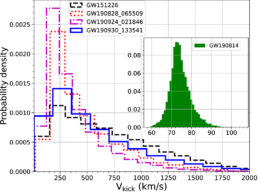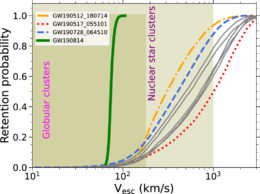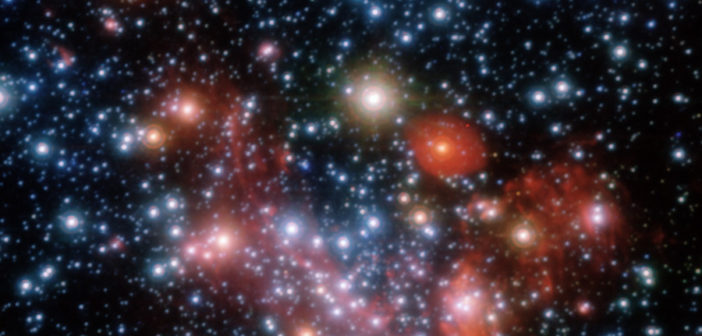A leading theory for how massive (and supermassive) black holes form is hierarchical merging — the idea that massive black holes are built from a series of collisions between lighter black holes. Densely packed environments like globular clusters and nuclear star clusters at the centers of galaxies are expected to be prime sites for black-hole mergers, but gravitational-wave “kicks” might get in the way.
Get a Kick Out of This
When black holes merge, they emit gravitational waves that carry away energy and momentum. The waves aren’t emitted equally in all directions, so the act of merging imparts a “kick” to the merger product. It’s far from a gentle nudge — typical kick velocities are estimated to be hundreds or thousands of kilometers per second. If a black hole gets a big enough kick, it can leave the dense cluster it formed in and emerge into rarefied space, where it’s far less likely to undergo further mergers. How typical is it for black holes to get ejected from their nascent star clusters, and what does it mean for the theory of hierarchical merging?

Probabilities of five merger products having a given kick velocity. [Adapted from Mahapatra et al. 2021]

Retention probability as a function of cluster escape velocity for several gravitational-wave events in the catalog. The grey lines correspond to five of the six merger events that showed signs of previous hierarchical mergers; the red dotted line is the sixth. [Mahapatra et al. 2021]
Globular vs Nuclear
Mahapatra and coauthors used their estimates to determine the probability of a merger product remaining in the cluster in which it formed as a function of the cluster’s escape velocity, finding a wide range of retention likelihoods. The authors pay special attention to the six events in the catalog that show signs of being the products of previous hierarchical mergers, like GW190521 — the most massive black-hole merger detected so far. They estimate that a merger like GW190521 would have a 50% chance of remaining bound to a star cluster that had an escape velocity of 700 km/s. Since this escape velocity is well within the expected range for nuclear star clusters, this means that if GW190521 were housed in such a dense environment, its massive product may well merge again in the future.
Ultimately, it’s clear that some star clusters are better at retaining post-merger black holes than others. Given their low escape velocities, globular clusters are unlikely to be the sites of repeated mergers; of the 40 cataloged mergers with the best data, the authors estimate that 17 would be retained by nuclear star clusters and only 2 would be retained by globular clusters. Without knowing more about the environments in which these mergers took place, it’s impossible to say whether an individual merger product will escape from its surroundings, but the authors’ findings have important implications for where hierarchical merging is likely to take place generally.
Citation
“Remnant Black Hole Kicks and Implications for Hierarchical Mergers,” Parthapratim Mahapatra et al 2021 ApJL 918 L31. doi:10.3847/2041-8213/ac20db

